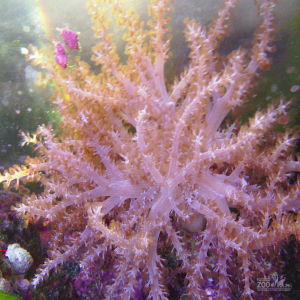 Kenya Tree coral has an erect tree-like structure with lateral branches that are heavily forked. On the top of the branches there are clusters of non-retractable polyps. The base or stalk is without polyps but has sclerites which makes the surface rough. Sclerites are calcium bodies that are various sizes like rice. The stalk is usually cream to brown with the polyps brown to greenish brown. There are a number of common names and corals are difficult to identify past genus, so species is left to the experts.
Kenya Tree coral has an erect tree-like structure with lateral branches that are heavily forked. On the top of the branches there are clusters of non-retractable polyps. The base or stalk is without polyps but has sclerites which makes the surface rough. Sclerites are calcium bodies that are various sizes like rice. The stalk is usually cream to brown with the polyps brown to greenish brown. There are a number of common names and corals are difficult to identify past genus, so species is left to the experts.
Location: Animals Formerly at Zoo
Share:
Range
Indo-Pacific and Red Sea
Habitat
This coral grows on deeper reef slopes where the water is clear with stronger currents. They can cover large expanses at depths of around 19 feet, colonizing hard substrates of stones and coral.
Conservation Status
Primary Threats
Gestation
The growth of the Kenya Tree Coral depends on the light and nutrients that are obtained from the surrounding water.
Litter
The number of budding and dropping of branches by the coral depends on the ledge that the coral is on and the success of its attachment needed for growth.
Behavior
The Kenya Tree coral does give off chemical toxins to ward off encroaching corals yet can be susceptible to the chemical toxins of other corals as well. The chemicals will affect hard corals if the colony is large, yet out of the entire genus this is the least toxic coral.
Reproduction
The Kenya Tree coral will reproduce by budding, fission, and dropping little branches.
Wild Diet
Although they use the symbiotic algae, zooxanthellae, that lives within their tissue, they are more dependent on outside food for survival. They depend on food in the water column like phytoplankton more so than light.
Zoo Diet

